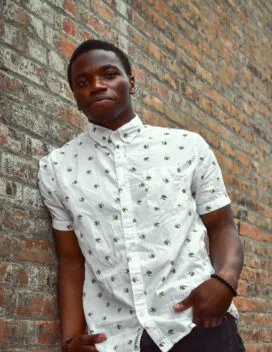Bio (hide this header in all alumni profiles)
Faithful Oladeji is a UX Designer & Researcher who leverages the principles of human-centered design to create functional, pleasant, and meaningful experiences for digital solutions. At the heart of this process is a persistent growth mindset, and a desire to see a world shaped by responsible innovation. Faithful earned an MFA in Design for Responsible Innovation in 2022 and a BSAS in Architectural Studies, also from Illinois, in 2019. Faithful currently works as a UI/UX Designer at Welldoc.

MFA Thesis
Presence in the UnBuilt Environment: Designing the User Experience of Architecture With Virtual Reality
Abstract
Architecture is the art and science of designing structures and spaces to be inhabited. The term also describes the product of the design process in this practice, often buildings for human use. Consistently the backdrop for activities of human life, buildings are one of the foremost interfaces with which humans interact. As interfaces, buildings permit physical and social relations between spaces and people and between people and people. Decades of research in the design disciplines and the behavioral sciences have shown that the sum of effects felt by users during and after their interaction with an interface is inextricably linked to its design. As a result, it has become critical for interface designers to actively consider the experience end-users will have, during the design process. Considering architecture as a monumentally-scaled interface charges architectural designers with the same responsibility. However, research indicates that for architecture students, considering the experience of end-users remains an elusive task. This is reflected by a number of issues in the design process of architecture students, including a character of low rigor in students’ design and research practices, and a general absence of explicit discourse about the experiential qualities of the built environment. In light of this, I designed a survey study involving a sample of architecture students at the University of Illinois was carried out to better understand how architecture students consider the experience of end-users in their process. Results of this study revealed that students largely rely on passive and distant methods for considering user experience and end users are largely missing as a source of design knowledge in their design process. Recent efforts to ground architecture as a more human centered practice have addressed a number of these issues, however the role of architectural representation remains a ripe opportunity for further research.
Representation is the vehicle that architectural students use to advance through their design process. It assists them in the negotiation of aspects of the built environment and it enables them to communicate their designs to others. However, research suggests that the conventional system of architectural representation students uses, which consists of drawings, renderings, and physical models is inadequate for expressing the experiential qualities of the built environment. Therefore, reliance on it is fundamentally unconducive to considering user experience in the design process and may even hinder how effectively architectural designers are able to evaluate the experience of end-users. Accordingly, through a comparative study this project probed the limits of this conventional system of representations and then asked whether introducing virtual reality can enable architecture students to more actively and effectively engage with the experience of end users in their design process. Virtual reality has been shown to provide a number of benefits as a form of architectural representation and has become common in professional practice. But in academia, it remains largely inaccessible to students. Therefore, I designed a virtual reality prototype that is accessible to students and applied it alongside the conventional mode of representation in a design review involving end-users. Findings indicate that the prototype can enable architecture students to conduct effective end-user research and generate empirical data that leads to useful insights about the user experience of their designs. Furthermore when applied along with conventional modes of representation, the virtual reality prototype is useful for checking assumptions made through the other modes of representation.
Read the designed thesis
Access via IDEALS
Explore Faithful Oladeji’s website


